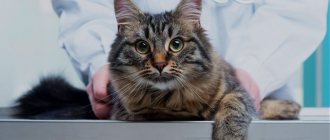Normal temperature for cats
The normal body temperature for humans is approximately +36.6 degrees Celsius. Of course, its indicators may vary depending on the time of day, the physical condition of the person at the time of its measurement and many other factors.
The physiological body temperature of cats is higher than that of humans, and averages +38 °C. In this regard, a cat’s ears will almost always seem hotter than their own body to a person.
It is worth mentioning separately about hairless cat breeds, for example, the same Sphynx. They may appear much hotter than a furred animal. This is primarily due to the fact that representatives of hairless breeds spend much more energy due to their inherent accelerated metabolism. Therefore, despite the fact that sphinxes may seem very hot to the touch, in most cases this is a physiological norm for the animals themselves.
How to tell if your cat's ears are hot
Of course, an experienced cat lover can determine by touch that his pet’s ears are much hotter than usual. And, naturally, such a phenomenon cannot but cause concern for the owner. Hot ears alone cannot serve as a reliable sign of illness in an animal. The cat's health status should be assessed using a whole range of different indicators. So, when an animal is sick, in addition to hot ears, the following signs may be present:
- change in the color of the auricle (with illness, it acquires a bright red tint);
The owner can notice redness of the ear with the naked eye
- increased temperature in the armpits and oral cavity;
- nose that is hot and dry to the touch;
- lethargy, apathy of the animal, refusal to eat.
If, along with hot ears, the cat has at least a few of the above signs, then only this is the basis for suspicion of the pet’s ill health.
When not to worry
The ears appear hotter than other parts of the cat's body due to the fact that there are blood vessels under thin skin that is not protected by fur. Due to their location, they quickly heat up from the sun, lamp, radiator and also cool down quickly (it is by the ears that you can determine that the animal is freezing).
From a heat source, the ears heat up faster than other parts of the cat’s body, since there is a dense network of capillaries, as close as possible to the skin
Warm ears themselves are not an indicator of fever (unlike a dry nose in an awake cat). But you should play it safe and measure the general body temperature of the beast with flaming ears (this is done using a rectal thermometer). The norm is:
- in a newborn kitten - 35.1–36.1 °C;
- for kittens up to six months - within 38.5–39.5 °C;
- for adult cats - 37.5–39 °C.
It's okay if the cat has hot ears, but the general body temperature is fine and there are no other alarming symptoms. Just in case, feel the animal’s ears after a short period of time - if the animal is overheated or nervous, then after 15–20 minutes the skin will again feel normal to the touch.
Why does a cat have hot ears?
There are many reasons why a cat's ears become hot. However, all of them can be combined into two groups:
- Physiological reasons. The temperature of the ears is influenced by many external factors, for example, being in a hot and stuffy room, or prolonged physical activity of the pet. Sometimes ordinary stress can provoke such hyperthermia. Newborn kittens and pregnant cats always have very hot ears.
- Pathological reasons. The most common among them are: infection with ear mites;
- colds;
- infectious diseases of the ears, for example, otitis media;
- injuries and hematomas;
- viral infections.
How to help an animal
Hot ears in a cat are not a pathology in themselves, which means that trying to cool only one ear (for example, by applying ice compresses) is pointless. The first thing to do is to examine the animal for other symptoms. If they are not there, then you should leave the cat alone for 20–30 minutes and feel the ears again - in a healthy animal, by this time the blood flow will normalize and the skin will no longer be hot.
When fiery ears are still a symptom of some kind of disease, it is necessary to begin treatment. It depends on the diagnosis:
- If the ears are burning due to severe stress, then first you need to create the most comfortable conditions for the cat and remove all irritants. There is no need to forcefully try to pick up the animal or stroke it (this will only increase the stress). It is better to provide maximum peace, but leave water and tasty food nearby. If after a couple of days the cat’s mental well-being is not restored, veterinarians will prescribe sedatives: Clomipramine;
- Cat Baiyun;
Kot Bayun is a sedative medicine based on natural herbal ingredients
- Fitex;
- Vetspokoin;
- Anti-stress;
- Phospasim;
- Vetranquil.
- Surolan;
Amitrazine is a veterinary drug that is used for cats in the treatment of pathologies caused by sarcoptic mites
During treatment of otitis media, ear mite infection, and after surgery, the cat must be wearing a medical collar that prevents the animal from scratching the sore ear.
If the cat has a fever
If the ears are hot, you need to make sure that the animal’s body temperature is normal. If you don’t have a thermometer, just feel the animal’s nose - it should be cold and wet when awake. If you have a temperature measuring tool at home, you should use it. For an adult cat, readings below 37.5˚C and above 40˚C are a serious reason to immediately contact a veterinarian. Fever occurs when:
- infectious diseases;
- poisoning;
- tumors;
- allergies.
Video: how to correctly measure a cat's temperature
Sometimes an emergency situation arises when it is impossible to quickly get an appointment with a specialist. Inaction during hyperthermia is dangerous, therefore the following measures are allowed to eliminate fever:
- Cover the animal for a couple of minutes with a towel soaked in cold water (do not put the cat in an ice bath, as this can cause heart attacks).
- Give the cat echinacea tincture at the rate of 1 drop per 1 kg of animal weight (dilute the drug with water in a ratio of 1:5).
- Place the antipyretic suppository Cefekon (50 mg for an adult cat, 25 mg for a kitten).
Remember, fever is a dangerous symptom. Even if you manage to knock it down, it is very important to take your cat to the vet as soon as possible. He will conduct an examination and find out the exact cause of the fever, which will help prescribe the correct treatment.
Many cat owners panic if their pets' ears become hot. But, according to experts, flaming ears themselves are not a reason to suspect a disease. You need to worry if the animal's general body temperature rises, it itches constantly, refuses to eat, and sleeps poorly. Such symptoms are already a reason to visit a veterinarian, find out the reason for the cat’s poor health and immediately begin treatment.
How to identify the cause of hot ears in a cat
Pathologies, in addition to elevated ear temperature, always manifest themselves with additional symptoms, which you should pay attention to first:
- Ear mite. Infection of cats with ear mites, which in veterinary practice is called otodectosis, is a fairly common phenomenon. It is worth noting that otodectosis can affect only one ear - in this case, the symptoms will be characteristic of only one ear. The disease is accompanied by: severe hyperthermia of the ears;
- presence of foul-smelling dark discharge from the ears;
- the formation of ulcers on the inner surface of the ear;
- restless behavior of the pet, expressed in attempts to comb its ears.
The owner of the animal can see with the naked eye not the ear mites themselves, but their metabolic products
- change in ear color (its inner side becomes red), local hyperthermia;
- increased ear temperature;
When a hematoma develops, the auricle swells and becomes red or bluish
- lethargy;
Video: otodectosis in a cat
How to perform a home ear examination
If a cat has hot ears, then he should have his auricle examined, the condition of which can be used to judge whether the animal has a particular pathology.
You can do this as follows:
- It is necessary to calm the pet. It is impossible to conduct an examination when the cat is in an aggressive or excited state.
- If touching the ear causes pain to the animal, it must be secured in a diaper or towel to protect itself from sharp claws.
A protective bag is a convenient device that will protect the owner from the sharp claws of the pet when examining it.
- The examination begins from the outside of the ear, it is noted whether there are any ulcers, scratches, scratches, or hair loss on it.
- Next, the inside is inspected; to do this, the animal’s ear should be slightly bent.
- Under no circumstances should you try to insert foreign objects deep into your cat's ear. This is fraught with damage to the hearing aid, infection, and this manipulation can cause an attack of acute pain in the pet.
- When examining the inside of the ear, you should pay attention to the color of the skin, the presence of discharge, ulcers and microtraumas.
How to measure a cat's temperature
It is almost impossible to reliably know whether a cat’s general body temperature is elevated by external signs. To do this, you should use the appropriate medical instruments - a thermometer.
Measure your pet's temperature like this:
- It is necessary to secure the animal with a towel or diaper.
- The tip of the thermometer must be lubricated with Vaseline or baby cream.
- The tip of the thermometer is placed into the cat's anus using rotational movements to a depth of no more than 1 cm.
- During insertion of the thermometer, you should hold your pet tightly, since this procedure is usually very unpleasant for him.
- When measuring temperature, the thermometer should be at an angle of approximately 30 degrees.
- After measurement, the thermometer must be washed and disinfected.
Measuring a cat's temperature takes on average about 2 minutes.
Video: how to measure a cat's temperature rectally
Once I had the opportunity to measure the temperature of my cat. According to the description, this is a simple matter, but in reality the process is very complex. First, you need an assistant. We kept the cat together; I definitely wouldn’t have been able to handle it alone, because the animal definitely wouldn’t lie quietly with a thermometer. Secondly, we were unable to wrap the hind legs securely right away, since we had to insert a thermometer under the tail, and we additionally wrapped them after inserting the thermometer. And thirdly, we also had to wrap up the cat’s face because she tried to bite. The animal’s suffering was not in vain, because the cat was really sick. Her temperature was closer to 40 degrees, and I quickly took her to the vet.
In what cases are hot ears a symptom of a disease?
If heating of the ears is accompanied by dark spots inside the ears, mucous discharge, vomiting, weakness and loss of appetite, diarrhea - these are already clear signs that the animal is sick. Most often, these symptoms occur when:
- severe stress of the animal;
- tick infestation;
- otitis;
- poisoning;
- infectious disease;
- injuries.
Ears can burn because the cat constantly scratches them - this occurs due to inflammation, otodectosis, ear infections or injuries.
Stress
Due to excitement, fear, and excitement, hormones are released, the pulse quickens, and blood pressure rises. Blood begins to flow faster through the vessels, causing the ears to quickly become hot. This is a short-term phenomenon - as soon as the animal calms down, the ears will cool down. But it happens that the animal is too worried and cannot come to its senses for a long time - this situation is dangerous and can lead to exhaustion (due to loss of appetite and insomnia) and cardiovascular pathologies. A pregnant cat may lose her kittens due to excitement.
You can recognize severe stress in a cat not only by hot ears, but also by the following external signs:
- The animal begins to go to the toilet frequently and may make puddles outside the litter box.
- The cat tries to hide, avoids contact with people (does not allow anyone to approach or stroke it, does not respond to words).
- She doesn’t sleep, but lies or sits and tensely watches everything that happens around her, flinches at every sound.
- Nervously twitches its tail or tucks it between its paws.
- The eyes are wide open, the pupils are enlarged, the whiskers (whiskers) are fanned out.
- Frequently licks, scratches and yawns. Makes guttural sounds.
- It moves almost crawling (on half-bent legs).
The most common causes of chronic stress:
- the appearance of a new person or animal in the family;
- a neighbor's cat or dog (which your pet hears or feels);
- too loud sounds from the street (fireworks, firecrackers, noise of construction equipment);
- changing of the living place.
The ears are hot and pointed to the sides, the eyes are wide open, the pupils are enlarged, the whiskers are spread out like a fan - all these are clear signs of a cat being very frightened
Ear mite
The ear mite is a yellow parasite. Its length is only 0.2–0.6 mm. It has an oval body and eight short, dense limbs. A cat is infected with such a mite through contact with another animal, through the owner’s clothes and shoes, where the parasite crawls on the street.
The Otodectes cynotis tick is difficult to notice with the naked eye; its length is less than one millimeter
Climbing inside the ear, the tick digs into the skin with microscopic jaws and begins to suck in intercellular fluid. This causes severe itching, the cat begins to intensively scratch the affected area - the ear becomes hot from constant scratching. Other symptoms of otodectosis (tick infection) are:
- purulent discharge from the ears;
- black dots that look like coffee grounds inside the ear canal (these are waste products of the parasite);
- the presence of scratches, scabs inside and around the ears.
You should also pay attention to the fact that the cat constantly shakes its head, tilts it, and presses its ear. If the wounds from the parasite's bites become infected, the pet will develop a fever, become weak, refuse to eat, and may begin vomiting.
Otodectosis must be treated as quickly as possible, as complications can threaten the pet’s life. An ear affected by a tick swells, plugs form, pressing on the eardrum, and the animal ceases to hear normally. Inflammation occurs in wounds, which can spread to the blood vessels and affect the nervous system. If the disease is advanced, it is possible to develop such concomitant pathologies as:
- purulent otitis;
- hematoma of the auricle;
- lymphatic extravasation (closed tissue damage with rupture of lymphatic vessels and accumulation of lymph in the newly formed cavity).
The contents of the external auditory canal during otodectosis (infestation with mites) is an accumulation of dark brown or black crumbs
Video: otodectosis in cats
Otitis
Otitis media most often occurs due to infection in open wounds (pathogens can be pneumococci, staphylococci, hemophilus influenzae). Otitis media may also be a consequence of:
- hypothermia;
- immune disorders;
- stenosis (narrowing) of the ear canals;
- foreign body in the ear canal.
The inflammatory process in the ear canal is always accompanied by an increase in the temperature of the auricle - the body tries to stop the pathological process by increasing the blood flow with which leukocytes are delivered to the site of inflammation (they perform a protective function by destroying pathogenic microorganisms). In addition to hot ears, otitis media is indicated by:
- purulent discharge with an unpleasant odor;
- the cat withdrawing its head when touched;
- constant scratching of the animal's sore ear;
- hearing impairment (the cat reacts worse to sounds);
- lack of coordination;
- The body temperature of a sick cat rises by 2–3 degrees.
Untreated otitis media can lead to complete hearing loss. The worst possible complication is the spread of inflammation to the lining of the brain and the development of meningitis. This is a deadly disease that is difficult to diagnose and difficult to treat in animals.
If you bathe a cat, then after water procedures, be sure to thoroughly wipe his ears - inflammation may begin in wet ears due to a draft.
Injuries
In a fight, falling on the head or being hit with a heavy object, a cat can get a hematoma of the external organ of hearing. Sometimes self-injury occurs - an animal with a tick or otitis media rubs its ears excessively and, as a result, injures itself.
A hematoma is a hemorrhage in the space between the cartilage and the skin of the auricle. The result is a tumor that compresses the nerve endings and causes pain.
An animal can get a head injury with ear hematoma if it falls from a height, for example, from a tree.
The sore ear will feel fiery to the touch. Symptoms are also observed:
- a scarlet or bluish swelling at the base of the ear, which the animal does not allow to be examined;
- the sore ear is unnaturally turned out or pressed against the head;
- the animal shows concern, shakes its head, tilts it to the side.
When a cat receives an ear injury, help is required, since in the absence of timely treatment there is a high risk of developing inflammatory processes, abscesses and even blood poisoning. After a hematoma, deformation of the auricle often develops, due to which hearing is seriously impaired.
Other diseases
Ears can become hot when there is a general increase in temperature that occurs due to allergies or an infectious infection. In both cases, in addition to the flaming ears, the animal will experience:
- apathy;
- weakness;
- lack of appetite;
- vomit;
- diarrhea.
An accurate diagnosis can only be made based on a series of tests in a veterinary clinic.
Another case in which a cat’s ears become fiery is frostbite. If, after a long stay in the cold, the animal, in addition to hot ears, experiences redness or discoloration of the skin, followed by peeling and the appearance of bleeding ulcers, it is necessary to urgently take the animal to the veterinarian. Only complex treatment will avoid possible amputation of the ears due to the onset of tissue necrosis.
We picked up a cat on the street in frosty weather of 27˚C. His ears were frostbitten. We didn't notice this right away. The cat was skinny, all wounded. They thought that the hot ears, the tips of which were slightly turned inward and covered with sores, were also a consequence of the fight. After 3 days, the wounds on the ears began to turn black and fester. They took me to the doctor, and he said that tissue death had already begun. The tips of the ears had to be amputated. To prevent necrosis from spreading, a long course of antibiotics was administered.
Video: why does a cat have hot ears and nose
How to rid your pet of the problem?
To relieve redness, you must first determine its cause. If this is an allergy, then antihistamines for cats - Suprastin, Demidrol, Pipolfen - will come to the rescue. If your cat has scabies, use an ointment made from tar and petroleum jelly.
If a cat has red ears inside, then this cannot be normal. The reason for this was one of the diseases described above. It is better to seek help from specialists who will suggest the correct treatment. But if this is not possible, you can try to determine the cause of the disease yourself and try to help the animal. The main thing is not to harm and not to give the cat drugs that can aggravate the situation. The best treatment is prevention. Cat owners should monitor the hygiene of their pets and regularly clean their ear canals. Then such an insidious symptom as redness of the cat’s ears will bypass her.
The health of a four-legged pet worries every caring owner. If a pet, always cheerful and affectionate, suddenly becomes lethargic and apathetic, then such a change in behavior will certainly alert the owner. The first thing he can do is feel the cat's ears and nose to check the temperature.
If they are wet and cold, there is nothing to worry about, but warm, dry ones may indicate, therefore, the presence of a dangerous disease in the animal’s body.
However, such indicators are not dogma. Only a veterinarian can diagnose the disease, but it would be useful for any cat lover to find out why a cat has hot ears and what needs to be done in such cases.
What to do: when to contact a veterinarian?
You should consult a doctor if, against the background of an ear symptom, the animal begins to sleep most of the time.
In cats, red ears are observed not only at elevated temperatures. Symptoms are also considered to be a lethargic, apathetic state, when the animal sleeps all the time, the color of the coat has changed, intestinal upset is noticeable, and occasionally vomiting. All these symptoms indicate the presence of viruses in the body, kidney stones, injuries, and infections. When an owner notices something is wrong with their own pet, it is recommended to seek help from a veterinarian.
It is not advisable to bring down the elevated temperature when the kitten is hot on your own. To alleviate the condition, you need to provide constant access to cool water and moisten the fur and skin with a damp towel.
When changing the food, you may notice reddened ears and paws, as this may be a consequence of a food allergy. For this reason, you need to take your cat to a veterinarian, who will examine the animal. Similar symptoms can also appear if the kitten has worms, then the paws also become hot. This is also considered a cause for concern.
Why might the temperature of the ears increase?
The main reasons why a cat has hot ears and a “burning” nose inside can be:
- Prolonged exposure to direct sunlight or near a heat source. Because of this, the kitten's ear often turns red.
- The animal sleeps for a long time on one side. The cat has warm ears, a hot nose to the touch, as well as a forehead and head.
- Active games, as a result of which the temperature of the ears of cats rises.
- Dry air and stuffiness in the room. At the same time, even the body, paws and pads on them turn red.
- Stressful situations. Hyperemia of these parts of the body occurs against their background.
- Sterilization. You may notice that healthy ears turn red after the sterilization procedure.
Inflammation
If the animal's disease is viral or bacterial in nature, then it can force it to meow a lot. Fluffy pets can become infected with bacteria and viruses that cause infectious diseases. This leads to inflammatory processes in the cat’s body, and the main reaction may be:
- apathetic state;
- lethargy;
- refusal of food;
- hot body, one/both ears and nose turn red;
- elevated temperature;
- blood when urinating;
- loud meowing when feeling unwell.
With such symptoms, it is recommended not to delay a visit to the veterinarian. To alleviate the cat's condition, you need to wrap it in a damp soft cloth or put ice on the surface of the body, which is first wrapped in a napkin. The result will be if you rub pink pads and paws with vinegar and water in a 1:2 ratio.
Stressful situations
A cat, like a person, can be subject to stress and anxiety. The animal gets used to the house, the person, the way of life and is able to react to all changes with high body temperature, ears and olfactory organ, although normally the cat has cold ears and a wet nose. The reasons are usually rearranging furniture, moving, strangers in the apartment, having other pets, trips, loud noises, visiting the veterinarian, walking outside.
It is recommended to help overcome such fears; you need to surround the cat with attention and affection.
Ear mite
The disease can be suspected by the characteristic discharge from the animal’s hearing organs. If the owner notices brown marks in the pet's ear, then we can judge the presence of a parasite. It is recommended to begin treatment promptly, as the mite can lead to complete or partial hearing loss. Only a doctor can detect this arthropod after scraping the ear. When otodectosis develops, the cat's ears are cold, but in the middle of the ear cavity the cat can make many scratches from claws. In this case, self-medication is prohibited; it is recommended to urgently consult a specialist. To alleviate the condition, you can drip hot, but not boiling, sunflower oil into the ear.
Development of otitis media
The cat is hot if this disease develops. Then the animal’s temperature rises, squelching sounds are heard and there is wet discharge from the ear. The fluffy pet does not allow you to touch the sore spot and meows loudly in pain. Urgent veterinary care is required and only in a specialized clinic. In case of otitis media, it is necessary to strictly follow all the instructions of the attending physician.
Pathological causes
Here are the main pathological causes of the condition in question:
- Colds.
- Otitis.
- Viral diseases.
- Intestinal disorders.
If any of these pathologies is present, the animal’s condition changes. Not only does his local temperature (ears, nose) rise, but also his general temperature. Lethargy occurs, appetite and physical activity decrease. Other symptoms may also occur, depending on the underlying cause of the problem.
But even if the above-described signs are present, it is necessary to measure the pet’s body temperature rectally. For this purpose, conventional or electronic measuring instruments are used. Before installing the thermometer, its tip must be lubricated with Vaseline and only after that the measuring device is inserted into the anus of the animal no more than 2-3 centimeters.
Elevated body temperature can be accompanied by any of the pathologies described above.
With otitis media, one of your pet's ears will be hotter than the other. In addition, other symptoms will be observed: ear itching, clear, brown, bloody or even purulent discharge.
Intestinal disorders are accompanied by decreased appetite, nausea, diarrhea, vomiting, elevated body temperature and decreased activity.
Colds, viral and infectious diseases can have a wide variety of symptoms: cough, loss of appetite, inflammation and redness of the mucous membranes, nasal discharge, fever, ulcerations in the mouth, etc.
Therefore, if you notice hot ears and a dry nose in a cat, as well as some of the symptoms described above, it is recommended to show the animal to a specialist.
Diagnosis and treatment
On the eve of a visit to the veterinarian, it is worth taking your furry's temperature.
Hot ears are an indicator of increased body temperature. If they turn red, this is a sign of high blood pressure. At home, before taking the animal to the veterinarian, you should measure the temperature. To do this, the tip of the thermometer must be smeared with Vaseline and inserted into the anus a couple of centimeters. The measurement duration should be approximately 3-4 minutes.
If the cat is nervous, shaking its head and scratching its ears, it is recommended to examine them. If there are signs of ear mites, the doctor prescribes a series of tests, such as examination under a microscope, scraping, and only after that prescribes treatment. As a rule, it consists of thoroughly washing the ear shells with vegetable oil, and prescribing blood purifying drugs and painkillers. When otitis develops, the veterinarian prescribes warm lotions and ear drops for cats. In stressful situations, when they affect the pet’s health, sedatives are prescribed, and valerian may be taken. If a cat has a bowel disorder, which is accompanied by an increase in temperature, you need to review the diet and introduce fermented milk products.
In what cases should you contact a veterinarian?
You should sound the alarm if your pet has a warm, dry nose along with hot ears. Be sure to measure your pet's temperature. An increase sometimes indicates that the cat has problems with the gastrointestinal tract, inflammation or infection in the body. A cat's ears may be hot after sterilization or cesarean section. She may be lethargic for a couple of days. Don't worry.
If after giving birth the cat is lethargic for more than two days, and her ears are not cold and her nose is dry, immediately measure her temperature. If it is high, contact your veterinarian.
After castration, the cat's ears may also be hot. In general, they tolerate this procedure without complications. Despite this, the pet needs care in the first days until it recovers from anesthesia. A normal temperature is indicated by a wet nose and a warm head.
Ear diseases can also affect your overall temperature. If a cat is bothered by ear diseases, it often tilts its head to the side, presses its ears, and does not allow the owner to touch them. If the disease is advanced, the cat may become aggressive, irritable, eat poorly, and not make contact. You should immediately contact your veterinarian if your pet has the following symptoms:
- the cat constantly shakes its head, as if water had gotten into it;
- when pressing on the shell, a squelching sound is heard from the ear canal;
- the ears smell bad;
- the inside of the ear is irritated, red, and has a rash on it;
- the inner surface is dirty, the serous discharge has changed color;
- there is restless scratching of the ears. The animal constantly scratches them with its paws and tries to rub them on the sofa or floor.
All these symptoms indicate that the cat has ear diseases. To find out the cause, you need to contact your veterinarian. He will accurately determine the disease, prescribe the correct treatment and tell the owners what to do.
Possible diseases
Normally, the shell of the ear outside and inside has a pale pink tint. Redness of the ears worries the owner, but pathological processes may not always be the cause of hyperemia.
Thus, an increase in blood pressure, which ultimately leads to redness of the ears, is observed in cats after active physical activity, sleep, or stress. Also, a pet’s ears may be hot to the touch if they are in a room with a temperature above 26 degrees.
Pathologies can also be causes of red ears. The main ones are:
- Allergic type reaction. A cat can develop allergies to food, medications, or chemicals. If a cat has an allergy, in addition to red ears, the following signs may be observed: breathing problems (clogged nose), discharge from the nasal passages, itching and flaking on the ears.
- Foreign body in the ear canal. When the inside of the shell is injured by blades of grass or small debris, irritation of the delicate skin of the ear occurs. In this case, the animal tries to independently remove the interfering object with its paw and behaves restlessly.
- Ear injuries. When fighting with other cats, pets often get injured. As a result of the injury, a subcutaneous hematoma may form, characterized by redness and swelling of the auricle. When a bacterial infection occurs, serious inflammation occurs, characterized by soreness, hot ears and restlessness of the animal.
- Otitis. Ear inflammation develops under the influence of various factors. This could be bacterial or fungal microflora, ear mites or allergies. When otitis develops, a cat experiences not only hyperemia of the ears, but also itching and pain. Delayed assistance can lead to complications. The development of the infectious process along the ascending path leads to deafness or meningitis (in serious advanced cases).
- Burns from direct sunlight. Red spots that appear on a cat's ears may be associated with the development of dermatitis due to sunburn. With minor damage to the outer part of the auricle, the animal experiences virtually no discomfort. But with deep damage, the skin from the burn begins to peel off, and wounds form. The danger of permanent sunburn is the degeneration of skin cells into squamous cell carcinoma.
- Ringworm. The appearance of redness in the ears is also associated with a disease caused by fungal microorganisms. Trichophytosis, namely this type of fungus is called lichen, leads to hyperemia of the affected areas, hair loss, itching and discomfort in the animal.
Prevention
We should also talk about the prevention of ear diseases:
If you carefully follow all preventive methods for caring for your pet, your furry friend will always delight its owner with good health, affection and good mood.
A cat is the cutest creature that can live in the same house with a person.
It is absolutely harmless, if you do not take allergies into account, it will help get rid of mice, calm and even heal illness in humans.
Is it possible to allow this animal to suffer? Of course not! To prevent this from happening, it is necessary to follow all prevention methods, strictly monitor his health condition and begin the treatment process in a timely manner.
Compared to people, cats have higher body temperatures, which makes many of their owners' fears regarding the pet's health unfounded.
If your cat has hot ears, do not immediately run to the veterinary clinic in panic. The external organs of hearing in cats are covered with extremely short hairs and thin skin, directly under which blood vessels are located, and in large numbers. By touching the animal's ears, a person, due to the difference in body temperature, may feel that the kitten's ears are hot and begin to worry. In fact, this phenomenon is considered normal, especially for hairless species.
To finally get rid of worries, you can touch the animal’s nose. If it is cool and a little damp, and the pet is still active (running, playing or eating), then it is absolutely healthy.
Also, you should not be puzzled by going to the veterinarian with the problem of why the cat has hot ears, if the pet does not have other, obvious signs of illness, and he himself demonstrates an excellent appetite and cheerfulness, he has. It is quite possible that he is simply hot, as can be guessed by his frequent feeding of the sippy cup and the search for cool places to rest.
Why does the cat have hot ears?
However, if a cat’s hot ears occur along with a high body temperature, then it is quite possible that the pet is sick. it is necessary rectally, lubricating the tip of the thermometer with Vaseline or oil. Hold the measuring device for at least three minutes.
If a cat has hot, red ears that it constantly scratches, it may indicate that the animal has ear mites. Also an alarming sign is swelling and decay of the external hearing organs, which is an important reason to urgently visit a veterinarian.
Should I worry?
Veterinarians say that the condition of a cat’s nose and ears has nothing to do with its health. At different times of the day, different breeds of cats may have hot ears.
Causes:
state after sleep;- active games;
- increased air temperature in the room;
- dry air;
- stress.
Normal body temperature for cats
In cats, body temperature indicators fluctuate between + 37.5 ... + 39 ° C.
After measurements, a kitten’s thermometer may show +39.5 °C, and this is the norm.
Hot ears are a physiological norm
Cat breeds that lack fur are hotter than other pets.
For example, sphinxes spend a large amount of energy heating their bodies. They have a faster metabolism, causing their neck temperatures to be higher than other felines.
The body temperature of such animals can rise to +40.5 °C.
If a cat has hot not only ears, but also a nose, then there may be serious health problems.
Various intestinal disorders
Ear mites (symptoms and treatment we discussed above)
There are a lot of infectious diseases that occur hidden and can only be identified by a specialist.
External and internal inflammatory processes
The cat may be injured, but if the damage is internal, you will not be able to determine it yourself
How to determine if your pet is sick
The cat has become lethargic, stopped eating, does not go to the toilet (or tries but fails), sneezes, and has a depressed and apathetic state. By measuring the temperature, you can determine whether there are inflammatory processes in the animal’s body.
What to do?
If your pet's behavior has changed dramatically. Visit a veterinarian, or make a house call, if possible. Don't let your pet's condition take its course. Help him and he will be grateful to you.
Let's sum it up
Clean, hot ears with a warm, moist nose are no cause for concern. The cat is active and that means everything is fine. Well, if hot ears are accompanied by a dry, hot nose and a general increase in temperature, and the above symptoms also appear, then he will not be able to cope without your help.
Now you know when to worry about your cat's hot ears and when not to.









